The Feasibility of Using the MFC Concept to Upcycle Mixed Recycled Plastics
Abstract
:1. Introduction
2. Selection of Recycled Materials
3. Experimental Methods
3.1. Materials
3.2. Preparation of Recycled MFCs
3.3. Characterisation of Recycled MFCs
4. Microstructural Study
4.1. Morphology Development of RFIMBs and RFMFCs
4.2. Morphology Development of RMPOIMBs and RMPOMFCs
4.3. Morphology Development of RPPtalcIMBs and RPPtalcMFCs
5. Thermal Properties
5.1. Crystallisation Behaviour of RFIMBs and RFMFCs
5.2. Crystallisation Behaviour of RMPOIMBs and RMPOMFCs
5.3. Crystallisation Behaviour of RPPtalcIMBs and RPPtalcMFCs
6. Mechanical Behaviour
6.1. Mechanical Properties of RFIMB and RFMFCs
6.2. Mechanical Properties of RMPOIMB and RMPOMFCs
6.3. Mechanical Properties of RPPtalcIMB and RPPtalcMFCs
7. Conclusions
- possible thermal degradation of the polymeric components;
- suboptimal viscosity ratios, which affect the mixing and drawing of fibres;
- unsuitable composition ratios;
- insufficient addition of the compatibilizer;
- the presence of other small % contaminations in the recycled plastics, such as remnants of adhesive layers or mis-sorted non-target plastics;
- the combination of flexible PET fibres with rigid reinforcement talc.
Supplementary Materials
Author Contributions
Funding
Institutional Review Board Statement
Informed Consent Statement
Data Availability Statement
Acknowledgments
Conflicts of Interest
References
- Al-Salem, S.M.; Lettieri, P.; Baeyens, J. Recycling and recovery routes of plastic solid waste (PSW): A review. Waste Manag. 2009, 29, 2625–2643. [Google Scholar] [CrossRef]
- Evstatiev, M.; Fakirov, S.; Krasteva, B.; Friedrich, K.; Covas, J.A.; Cunha, A.M. Recycling of poly(ethylene terephthalate) as polymer-polymer composites. Polym. Eng. Sci. 2002, 42, 826–835. [Google Scholar] [CrossRef]
- Lei, Y.; Wu, Q.; Zhang, Q. Morphology and properties of microfibrillar composites based on recycled poly (ethylene terephthalate) and high density polyethylene. Compos. Part A Appl. Sci. Manuf. 2009, 40, 904–912. [Google Scholar] [CrossRef]
- Lei, Y.; Wu, Q.; Clemons, C.M.; Guo, W. Phase structure and properties of poly (ethylene terephthalate)/high-density polyethylene based on recycled materials. J. Appl. Polym. Sci. 2009, 113, 1710–1719. [Google Scholar] [CrossRef]
- Ragaert, K.; Hubo, S.; Delva, L.; Veelaert, L.; Du Bois, E. Upcycling of contaminated post-industrial polypropylene waste: A design from recycling case study. Polym. Eng. Sci. 2018, 58, 528–534. [Google Scholar] [CrossRef]
- Schiers, J. Polymer Recycling: Science, Technology and Applications; Wiley & Sons Ltd.: Chichester, UK, 1998. [Google Scholar]
- Ragaert, K.; Delva, L.; Van Geem, K. Mechanical and chemical recycling of solid plastic waste. Waste Manag. 2017, 69, 24–58. [Google Scholar] [CrossRef]
- Economics, M. The Circular Economy—A Powerful Force for Climate Mitigation; Material Economics Sverige AB: Stockholm, Sweden, 2018. [Google Scholar]
- Plastics Europe, EPRO. Plastics—The Facts 2019; Plastics Europe, EPRO: Brussels, Belgium, 2019; Volume 2019, p. 38. [Google Scholar]
- Brouwer, M.; Picuno, C.; van Velzen, E.U.T.; Kuchta, K.; De Meester, S.; Ragaert, K. The impact of collection portfolio expansion on key performance indicators of the Dutch recycling system for Post-Consumer Plastic Packaging Waste, a comparison between 2014 and 2017. Waste Manag. 2019, 100, 112–121. [Google Scholar] [CrossRef]
- Europian Commission. Closing the Loop—An EU Action Plan for the Circular Economy. COM 614 Final. 2015. Available online: https://eur-lex.europa.eu/legal-content/EN/TXT/HTML/?uri=CELEX:52015DC0614&from=ES (accessed on 2 December 2015).
- Ragaert, K. An Introductory Review Mechanical Recycling of Polymers for Dummies 2019. UBuntoo. Available online: https://ubuntoo.com/blogs/mechanical-recycling-for-dummies (accessed on 22 May 2019).
- Jiang, C.H.; Xu, X.B.; Li, Z.M. Application of in situ microfibrillization to recycling ultraviolet-aged poly (ethylene terephthalate) (PET) and high density polyethylene (HDPE). J. Macromol. Sci. Part B Phys. 2008, 47, 10–25. [Google Scholar] [CrossRef]
- Evstatiev, M.; Fakirov, S. Microfibrillar reinforcement of polymer blends. Polymer 1992, 33, 877–880. [Google Scholar] [CrossRef]
- Fakirov, S.; Evstatiev, M.; Schultz, J.M. Microfibrillar reinforced composite from drawn poly(ethylene terephthalate)/nylon-6 blend. Polymer 1993, 34, 4669–4679. [Google Scholar] [CrossRef]
- Evstatiev, M.; Fakirov, S.; Friedrich, K. Effect of blend composition on the morphology and mechanical properties of microfibrillar composites. Appl. Compos. Mater. 1995, 2, 93–106. [Google Scholar] [CrossRef]
- Evstatiev, M.; Nicolov, N.; Fakirov, S. Morphology of microfibrillar reinforced composites PET/PA 6 blend. Polymer 1996, 37, 4455–4463. [Google Scholar] [CrossRef]
- Fakirov, S. The Concept of Micro-or Nanofibrils Reinforced Polymer-Polymer Composites; Carl Hanser Verlag: Munich, Germany, 2012. [Google Scholar]
- Fuchs, C.; Bhattacharyya, D.; Fakirov, S. Microfibril reinforced polymer-polymer composites: Application of Tsai-Hill equation to PP/PET composites. Compos. Sci. Technol. 2006, 66, 3161–3171. [Google Scholar] [CrossRef]
- Li, Z.M.; Yang, W.; Xie, B.H.; Shen, K.Z.; Huang, R.; Yang, M.B. Morphology and tensile strength prediction of in situ microfibrillar poly(ethylene terephthalate)/polyethylene blends fabricated via slit-die extrusion-hot stretching-quenching. Macromol. Mater. Eng. 2004, 289, 349–354. [Google Scholar] [CrossRef]
- Friedrich, K.; Evstatiev, M.; Fakirov, S.; Evstatiev, O.; Ishii, M.; Harrass, M. Microfibrillar reinforced composites from PET/PP blends: Processing, morphology and mechanical properties. Compos. Sci. Technol. 2005, 65, 107–116. [Google Scholar] [CrossRef]
- Shields, R.J.; Bhattacharyya, D.; Fakirov, S. Fibrillar polymer-polymer composites: Morphology, properties and applications. J. Mater. Sci. 2008, 43, 6758–6770. [Google Scholar] [CrossRef]
- Kuzmanović, M.; Delva, L.; Cardon, L.; Ragaert, K. The effect of injection molding temperature on the morphology and mechanical properties of PP/PET blends and microfibrillar composites. Polymers 2016, 8, 13–18. [Google Scholar] [CrossRef] [Green Version]
- Kuzmanović, M.; Delva, L.; Cardon, L.; Ragaert, K. A Review: Relationship between Processing, Structure and Properties of the Microfibrillar Composites. Adv. Mater. 2020, 32, 2003938. [Google Scholar]
- Jiang, C.H.; Zhong, G.J.; Li, Z.M. Recyclability of in situ microfibrillar poly(ethylene terephthalate)/high-density polyethylene blends. Macromol. Mater. Eng. 2007, 292, 362–372. [Google Scholar] [CrossRef]
- Fakirov, S. Nano- and microfibrillar single-polymer composites: A review. Macromol. Mater. Eng. 2013, 298, 9–32. [Google Scholar] [CrossRef]
- Kuzmanović, M.; Delva, L.; Mi, D.; Martins, C.I.; Cardon, L.; Ragaert, K. Development of crystalline morphology and its relationship with mechanical properties of PP/PET microfibrillar composites containing POE and POE-g-MA. Polymers 2018, 10, 291. [Google Scholar] [CrossRef] [PubMed] [Green Version]
- Yi, X.; Chen, C.; Zhong, G.J.; Xu, L.; Tang, J.H.; Ji, X. Suppressing the skin-core structure of injection-molded isotactic polypropylene via combination of an in situ microfibrillar network and an interfacial compatibilizer. J. Phys. Chem. B 2011, 115, 7497–7504. [Google Scholar] [CrossRef] [PubMed]
- Xu, L.; Zhong, G.J.; Ji, X.; Li, Z.M. Crystallization behavior and morphology of one-step reaction compatibilized microfibrillar reinforced isotactic polypropylene/poly(ethylene terephthalate) (iPP/PET) blends. Chin. J. Polym. Sci. 2011, 29, 540–551. [Google Scholar] [CrossRef]
- Van Kets, K.; Delva, L.; Ragaert, K. Structural stabilizing effect of SEBSgMAH on a PP-PET blend for multiple mechanical recycling. Polym. Degrad. Stab. 2019, 166, 60–72. [Google Scholar] [CrossRef]
- Kaiser, K.; Schmid, M.; Schlummer, M. Recycling of polymer-based multilayer packaging: A review. Recycling 2018, 3, 1. [Google Scholar] [CrossRef] [Green Version]
- Delva, L.; Deceur, C.; Van Damme, N.; Ragaert, K. Compatibilization of PET-PE blends for the recycling of multilayer packaging foils. AIP Conf. Proc. 2019, 2055. [Google Scholar] [CrossRef] [Green Version]
- De Schrijver, I.; Desplentere, F.; Delva, L.; De Tandt, E.; Ragaert, K. Open-loop recycling of PET-PE post-industrial multi-layered plastic waste. In Proceedings of the International Conference on Polymers and Moulds Innovations-PMI 2018, Guimaraes, Portugal, 19–21 September 2018. [Google Scholar]
- Delva, L.; De Tandt, E.; Ragaert, K. Combining polymeric waste streams to improve functional properties of post-consumer mixed polyolefines. In Proceedings of the International Conference on Polymers and Moulds Innovations-PMI 2018, Guimaraes, Portugal, 19–21 September 2018. [Google Scholar]
- Roosen, M.; Mys, N.; Kusenberg, M.; Billen, P.; Dumoulin, A.; Dewulf, J. Detailed Analysis of the Composition of Selected Plastic Packaging Waste Products and Its Implications for Mechanical and Thermochemical Recycling. Environ. Sci. Technol. 2020, 54, 13282–13293. [Google Scholar] [CrossRef]
- Van Belle, A.; Demets, R.; Mys, N.; Van Kets, K.; Dewulf, J.; Van Geem KDe Meester, S.; Ragaert, K. Microstructural Contributions of Different Polyolefins to the Deformation Mechanisms of Their Binary Blends. Polymers 2020, 12, 1171. [Google Scholar] [CrossRef]
- Huysman, S.; De Schaepmeester, J.; Ragaert, K.; Dewulf, J.; De Meester, S. Performance indicators for a circular economy: A case study on post-industrial plastic waste. Resour. Conserv. Recycl. 2017, 120, 46–54. [Google Scholar] [CrossRef]
- Ragaert, K.; Huysveld, S.; Vyncke, G.; Hubo, S.; Veelaert, L.; Dewulf, J. Design from recycling: A complex mixed plastic waste case study. Resour. Conserv. Recycl. 2020, 155, 104646. [Google Scholar] [CrossRef]
- Shanks, R.A.; Li, J.; Yu, L. Polypropylene-polyethylene blend morphology controlled by time-temperature-miscibility. Polymer 2000, 41, 2133–2139. [Google Scholar] [CrossRef]
- Hubo, S.; Delva, L.; Van Damme, N.; Ragaert, K. Blending of recycled mixed polyolefins with recycled polypropylene: Effect on physical and mechanical properties. AIP Conf. Proc. 2016, 1779. [Google Scholar] [CrossRef] [Green Version]
- Hubo, S.; Leite, L.; Martins, C.; Ragaert, K. Evaluation of post-industrial and post-consumer polyolefin-based polymer waste streams for injection moulding. In Proceedings of the 6th Polymers & Mould Innovations International Conference, Guimarães, Portugal, 10–12 September 2014; pp. 201–206. [Google Scholar]
- Delva, L.; Cardon, L.; Ragaert, K. Evaluation of post-consumer mixed polyolefines and their injection moulded blends with virgin polyethylene. Environ. Eng. Manag. J. 2018, 17, 427–434. [Google Scholar] [CrossRef]
- Buekens, A.; Yang, J. Recycling of WEEE plastics: A review. J. Mater. Cycles Waste Manag. 2014, 16, 415–434. [Google Scholar] [CrossRef]
- Vyncke, G.; Onnekink, J.; Feenstra, T.; Ragaert, K. Design from Recycling for post-consumer WEEE plastics. In Proceedings of the International Conference on Polymers and Moulds Innovations-PMI 2018, Guimaraes, Portugal, 19–21 September 2018; p. 6. [Google Scholar]
- Schlummer, M.; Gruber, L.; Mäurer, A.; Wolz, G.; Van Eldik, R. Characterisation of polymer fractions from waste electrical and electronic equipment (WEEE) and implications for waste management. Chemosphere 2007, 67, 1866–1876. [Google Scholar] [CrossRef] [PubMed]
- Vyncke, G.; Fiorio, R.; Cardon, L.; Ragaert, K. The effect of polyethylene on the properties of talc-filled recycled polypropylene. Plast. Rubber Compos. 2020, 1–8. [Google Scholar] [CrossRef]
- Achilias, D.S.; Antonakou, E.V. Chemical and Thermochemical Recycling of Polymers from Waste Electrical and Electronic Equipment; InTech: Nappanee, IN, USA, 2015; pp. 306–315. [Google Scholar]
- Fu, S.Y.; Lauke, B. Fracture resistance of unfilled and calcite-particle-filled ABS composites reinforced by short glass fibers (SGF) under impact load. Compos. Part A Appl. Sci. Manuf. 1998, 29, 631–641. [Google Scholar] [CrossRef]
- Fu, S.Y.; Lauke, B. Characterization of tensile behaviour of hybrid short glass fibre/calcite particle/ABS composites. Compos. Part A Appl. Sci. Manuf. 1998, 29, 575–583. [Google Scholar] [CrossRef]
- Hargarter, N.; Friedrich, K.; Catsman, P. Mechanical properties of glass fiber/talc/polybutylene-terephthalate composites as processed by the radlite technique. Compos. Sci. Technol. 1993, 46, 229–244. [Google Scholar] [CrossRef]
- Hartikainen, J.; Lindner, M.; Harmia, T.; Friedrich, K. Mechanical properties of polypropylene composites reinforced with long glass fibres and mineral fillers. Plast. Rubber Compos. 2004, 33, 77–84. [Google Scholar] [CrossRef]
- Jayanarayanan, K.; Bhagawan, S.S.; Thomas, S.; Joseph, K. Morphology development and non isothermal crystallization behaviour of drawn blends and microfibrillar composites from PP and PET. Polym. Bull. 2008, 60, 525–532. [Google Scholar] [CrossRef]
- Badia, J.D.; Strömberg, E.; Karlsson, S.; Ribes-Greus, A. The role of crystalline, mobile amorphous and rigid amorphous fractions in the performance of recycled poly (ethylene terephthalate) (PET). Polym. Degrad. Stab. 2012, 97, 98–107. [Google Scholar] [CrossRef] [Green Version]
- González-González, V.A.; Neira-Velázquez, G.; Angulo-Sánchez, J.L. Polypropylene chain scissions and molecular weight changes in multiple extrusion. Polym. Degrad. Stab. 1998, 60, 33–42. [Google Scholar] [CrossRef]
- Meijer, H.E.H.; Govaert, L.E. Mechanical performance of polymer systems: The relation between structure and properties. Prog. Polym. Sci. 2005, 30, 915–938. [Google Scholar] [CrossRef]
- Yi, X.; Xu, L.; Wang, Y.L.; Zhong, G.J.; Ji, X.; Li, Z.M. Morphology and properties of isotactic polypropylene/poly(ethylene terephthalate) in situ microfibrillar reinforced blends: Influence of viscosity ratio. Eur. Polym. J. 2010, 46, 719–730. [Google Scholar] [CrossRef]
- Taylor, G.I. The viscosity of a fluid containing small drops of another fluid. Proc. R. Soc. Ser. A 1932, 138, 41–48. [Google Scholar]
- Zhao, C.; Mark, L.H.; Alshrah, M.; Soltani, I.; Lee, P.C.; Park, C.B. Challenge in manufacturing nanofibril composites with low matrix viscosity: Effects of matrix viscosity and fibril content. Eur. Polym. J. 2019, 121, 109310. [Google Scholar] [CrossRef]
- Daw, J.D.; Nicholson, P.S.; Embury, J.D. Inhomogeneous dehydroxylation of talc. J. Am. Ceram. Soc. 1972, 55, 149–151. [Google Scholar] [CrossRef]
- Fakirov, S.; Bhattacharyya, D.; Lin, R.J.T.; Fuchs, C.; Friedrich, K. Contribution of coalescence to microfibril formation in polymer blends during cold drawing. J. Macromol. Sci. Part B Phys. 2007, 46, 183–194. [Google Scholar] [CrossRef]
- Lin, X.D.; Cheung, W.L. Study of poly(ethylene terephthalate)/polypropylene microfibrillar composites. I. Morphological development in melt extrusion. J. Appl. Polym. Sci. 2003, 89, 1743–1752. [Google Scholar] [CrossRef]
- Lin, X.D.; Jia, D.; Leung, F.K.P.; Cheung, W.L. Study on poly (ethylene terephthalate)/polypropylene microfibrillar composites. II. Solid-state drawing behavior. J. Appl. Polym. Sci. 2004, 93, 1989–2000. [Google Scholar] [CrossRef]
- Evstatiev, M.; Apostolov, A.A.; Denchev, Z.; Fakirov, S.; Friedrich, K. Transcrystallization with reorientation of polyethylene in a drawn PET/PE blend as revealed by waxs of synchrotron radiation. Int. J. Polym. Mater. Polym. Biomater. 2004, 53, 847–857. [Google Scholar] [CrossRef]
- Aumnate, C.; Rudolph, N.; Sarmadi, M. Recycling of polypropylene/polyethylene blends: Effect of chain structure on the crystallization behaviors. Polymers 2019, 11, 1456. [Google Scholar] [CrossRef] [Green Version]
- Lin, J.H.; Pan, Y.J.; Liu, C.F.; Huang, C.L.; Hsieh, C.T.; Chen, C.K. Preparation and compatibility evaluation of polypropylene/high density polyethylene polyblends. Materials 2015, 8, 8850–8859. [Google Scholar] [CrossRef] [PubMed] [Green Version]
- Naiki, M.; Fukui, Y.; Matsumura, T.; Nomura, T.; Matsuda, M. Effect of talc on the crystallization of isotactic polypropylene. J. Appl. Polym. Sci. 2001, 79, 1693–1703. [Google Scholar] [CrossRef]
- Xavier, S.F.; Sharma, Y.N. Transcrystallinity and interfacial bondage in polypropylene-mica composites. Die. Angew. Makromol. Chem. 1984, 127, 145–152. [Google Scholar] [CrossRef]
- Velasco, J.I.; De Saja, J.A.; Martínez, A.B. Crystallization behavior of polypropylene filled with surface-modified talc. J. Appl. Polym. Sci. 1996, 61, 125–132. [Google Scholar] [CrossRef]
- Qiu, F.; Wang, M.; Hao, Y.; Guo, S. The effect of talc orientation and transcrystallization on mechanical properties and thermal stability of the polypropylene/talc composites. Compos. Part A Appl. Sci. Manuf. 2014, 58, 7–15. [Google Scholar] [CrossRef]
- Ammar, O.; Bouaziz, Y.; Haddar, N.; Mnif, N. Talc as Reinforcing Filler in Polypropylene Compounds: Effect on Morphology and Mechanical Properties. Polym. Sci. 2017, 3, 8. [Google Scholar] [CrossRef] [Green Version]
- Apostolov, A.A.; Samokovliyski, O.; Fakirov, S.; Stribeck, N.; Denchev, Z.; Evstatiev, M. Transcrystallisation with reorientation of polypropylene in drawn PET/PP and PA66/PP blends. Part 1. Study with WAXS of synchrotron radiation. Prog. Colloid. Polym. Sci. 2005, 130, 159–166. [Google Scholar] [CrossRef]
- Wan, H.Q.; Ji, X. Morphology and non-isothermal crystallization of in-situ microfibrillar poly(ethylene terephthalate)/polyethylene blend obtained via rod die extrusion and hot stretch. J. Mater. Sci. 2004, 39, 6839–6842. [Google Scholar] [CrossRef]
- Li, Z.M.; Yang, W.; Li, L.B.; Xie, B.H.; Huang, R.; Yang, M.B. Morphology and Nonisothermal Crystallization of in situ Microfibrillar Poly(ethylene terephthalate)/Polypropylene Blend Fabricated through Slit-Extrusion, Hot-Stretch Quenching. J. Polym. Sci. Part B Polym. Phys. 2004, 42, 374–385. [Google Scholar] [CrossRef]
- Li, Z.M.; Lu, A.; Lu, Z.Y.; Shen, K.Z.; Li, L.B.; Yang, M.B. In-situ microfibrillar PET/iPP blend via a slit die extrusion, hot stretching and quenching process: Influences of PET concentration on morphology and crystallization of iPP at a fixed hot stretching ratio. J. Macromol. Sci. Phys. 2005, 44, 203–216. [Google Scholar] [CrossRef]
- Chen, Y.H.; Zhong, G.J.; Li, Z.M. Microfibril reinforced polymer-polymer composites via hot stretching: Preparation, structure and properties. Synth. Polym. Compos. 2012, 401–436. [Google Scholar] [CrossRef]
- Lopez-Manchado, M.A.; Arroyo, M. Crystallization kinetics of polypropylene: Part 4: Effect of unmodified and azide-modified PET and PA short fibres. Polymer 1999, 40, 487–495. [Google Scholar] [CrossRef]
- Mys, N.; Delva, L.; Kuzmanovic, M.; Wieme, T.; Ragaert, K. Functional evaluation of compatibilization systems for recycled PP-PET blends. In Proceedings of the International Conference on Polymers and Moulds Innovations-PMI 2018, Guimaraes, Portugal, 19–21 September 2018. [Google Scholar]
- G’Sell, C.; Bai, S.L.; Hiver, J.M. Polypropylene/polyamide 6/polyethylene-octene elastomer blends. Part 2: Volume dilatation during plastic deformation under uniaxial tension. Polymer 2004, 45, 5785–5792. [Google Scholar] [CrossRef]
- Mofokeng, T.G.; Ray, S.S.; Ojijo, V. Influence of selectively localised nanoclay particles on non-isothermal crystallisation and degradation behaviour of PP/LDPE blend composites. Polymers 2018, 10, 245. [Google Scholar] [CrossRef] [Green Version]
- Schrauwen, B.A.G. Deformation and Failure of Semicrystalline Polymer Systems: Influence of Micro and Molecular Structure; Technische Universiteit Eindhoven: Eindhoven, The Netherlands, 2003. [Google Scholar] [CrossRef]
- Radusch, H.J.; Ding, J.; Akovali, G. Compatibilization of heterogeneous polymer mixtures from the plastics waste streams. In Frontiers in the Science and Technology of Polymer Recycling; Springer: Berlin/Heidelberg, Germany, 1998; pp. 153–189. [Google Scholar]
- Clemons, C. Elastomer modified polypropylene–polyethylene blends as matrices for wood flour–plastic composites. Compos. Part A Appl. Sci. Manuf. 2010, 41, 1559–1569. [Google Scholar] [CrossRef]
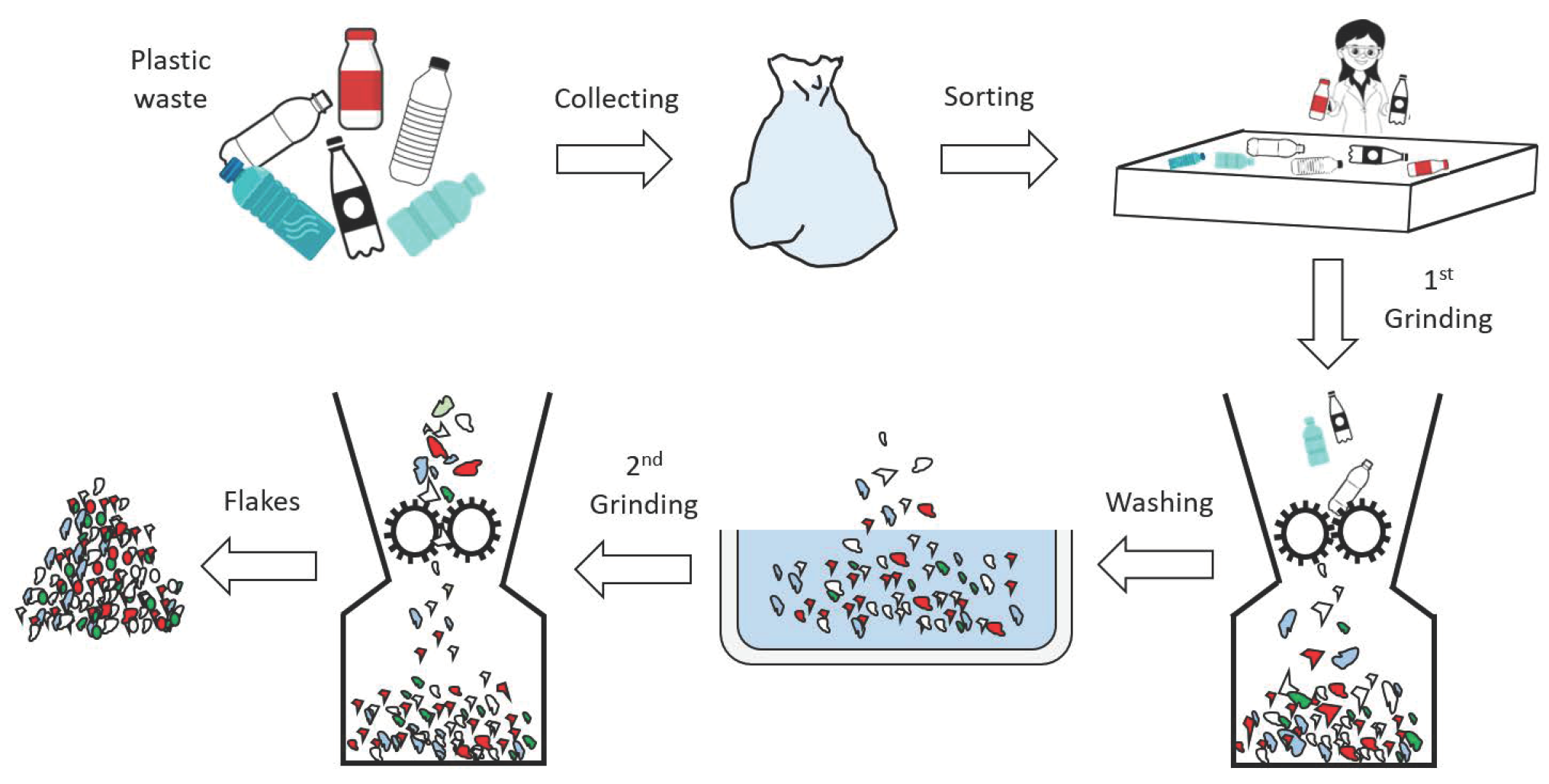

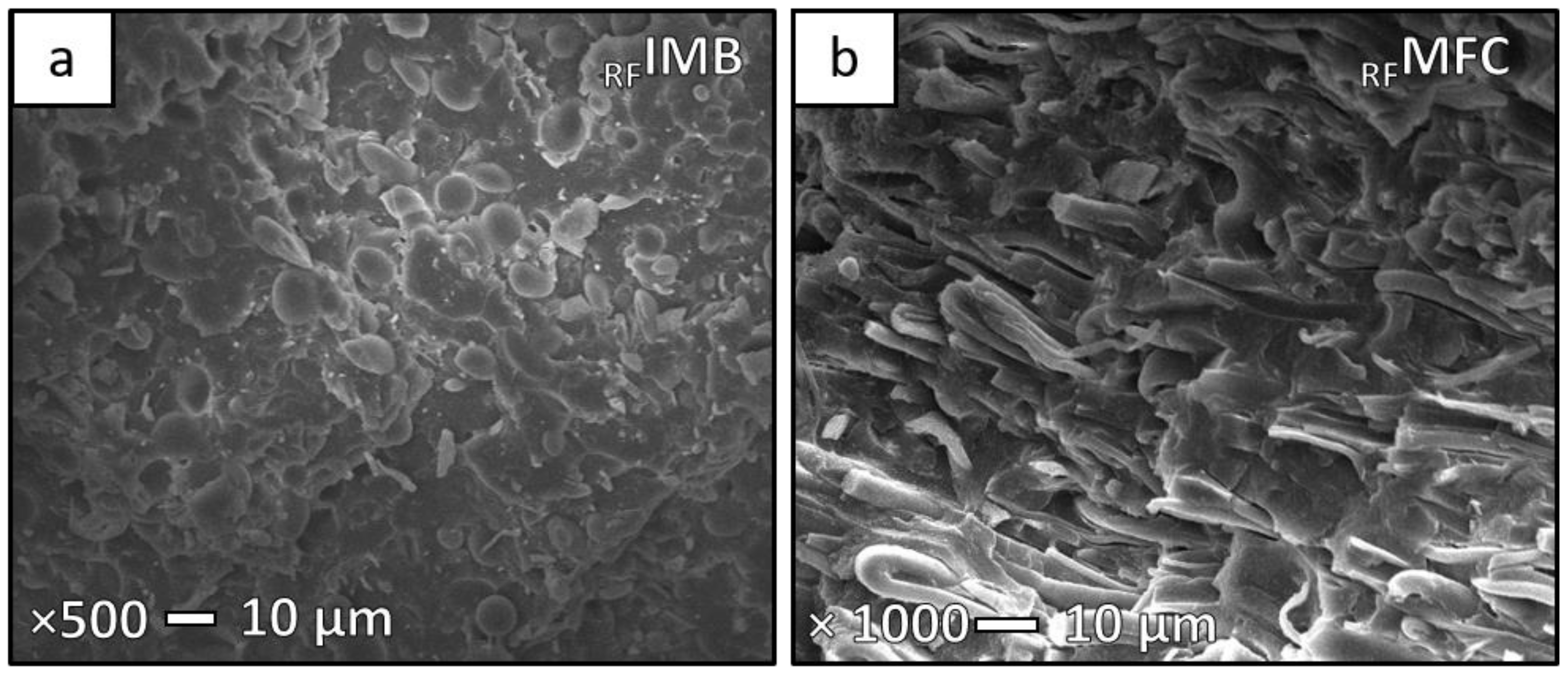

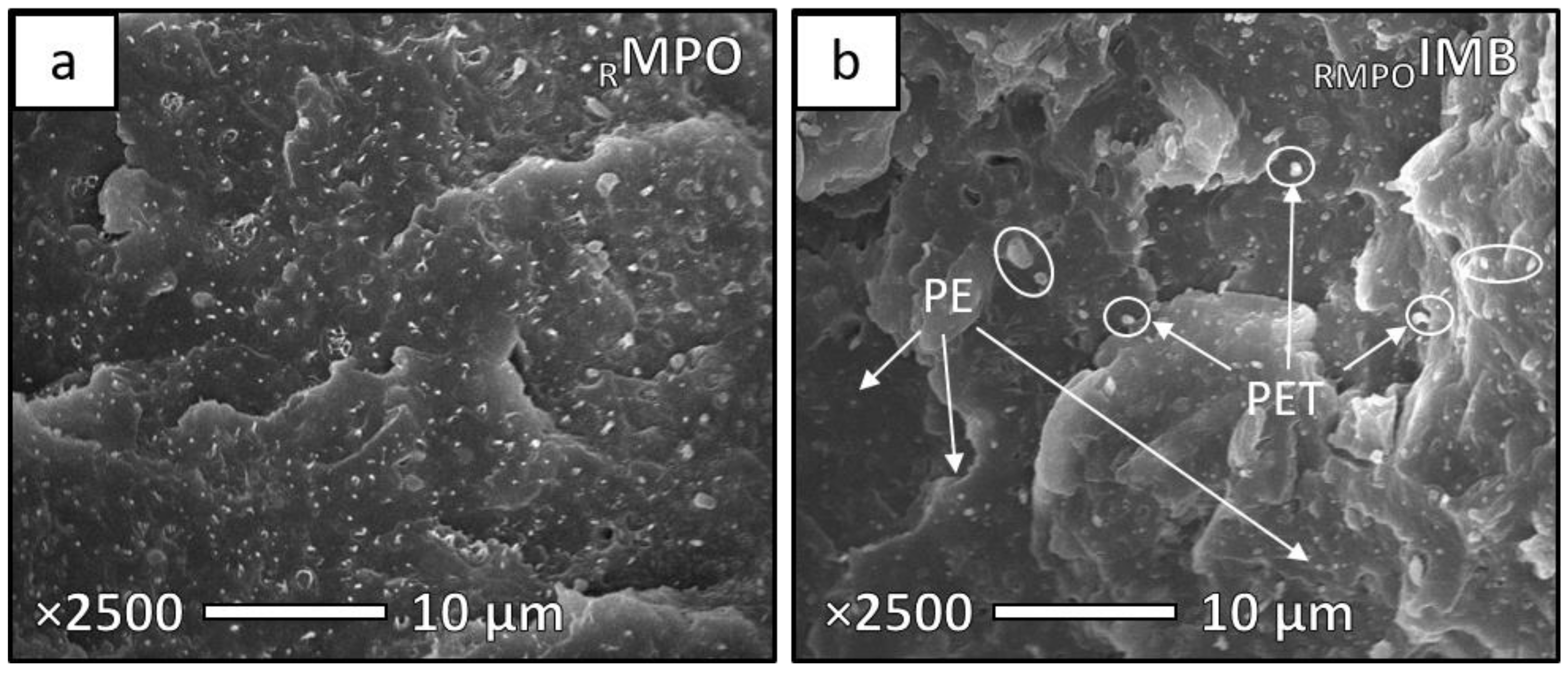


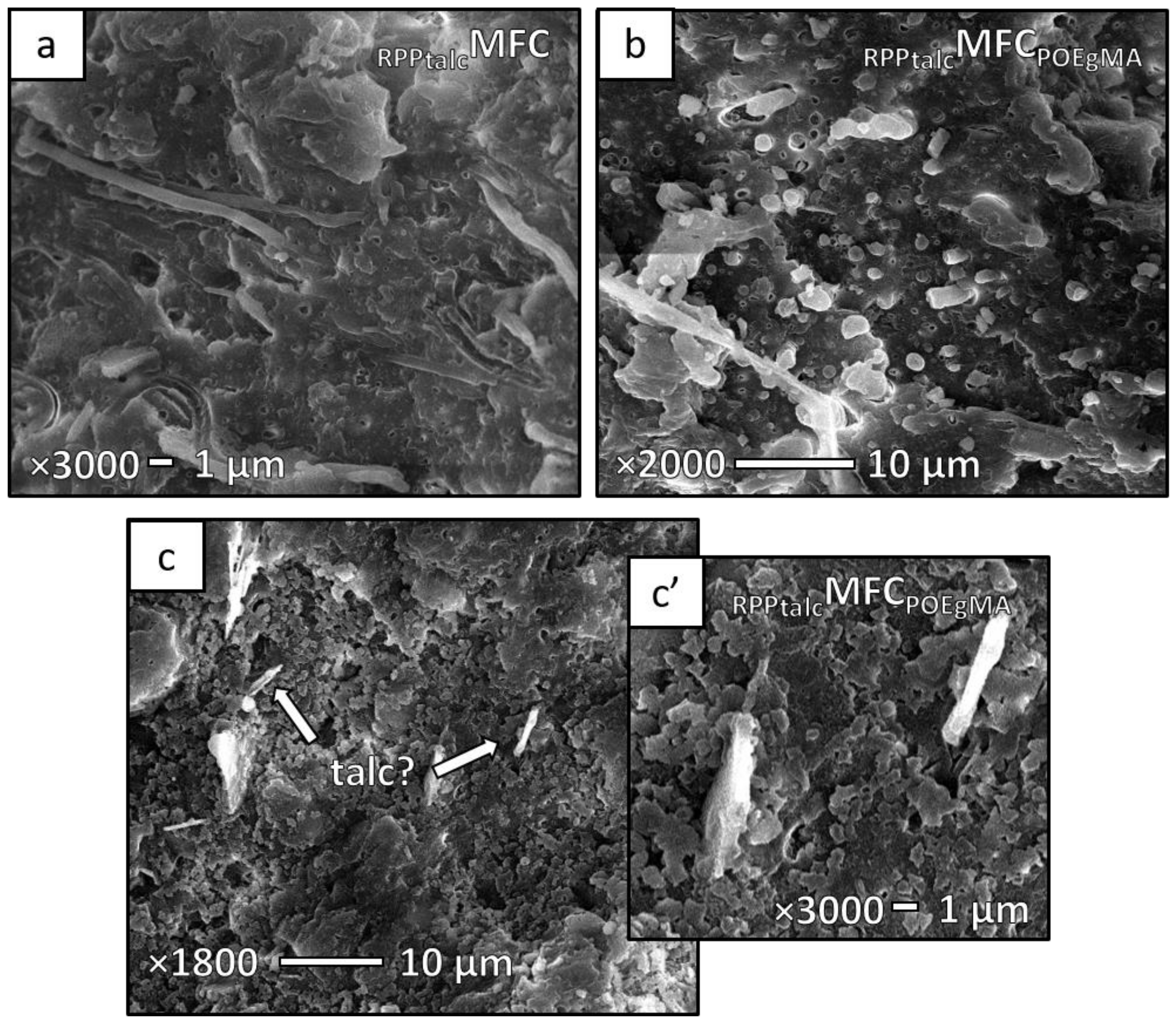
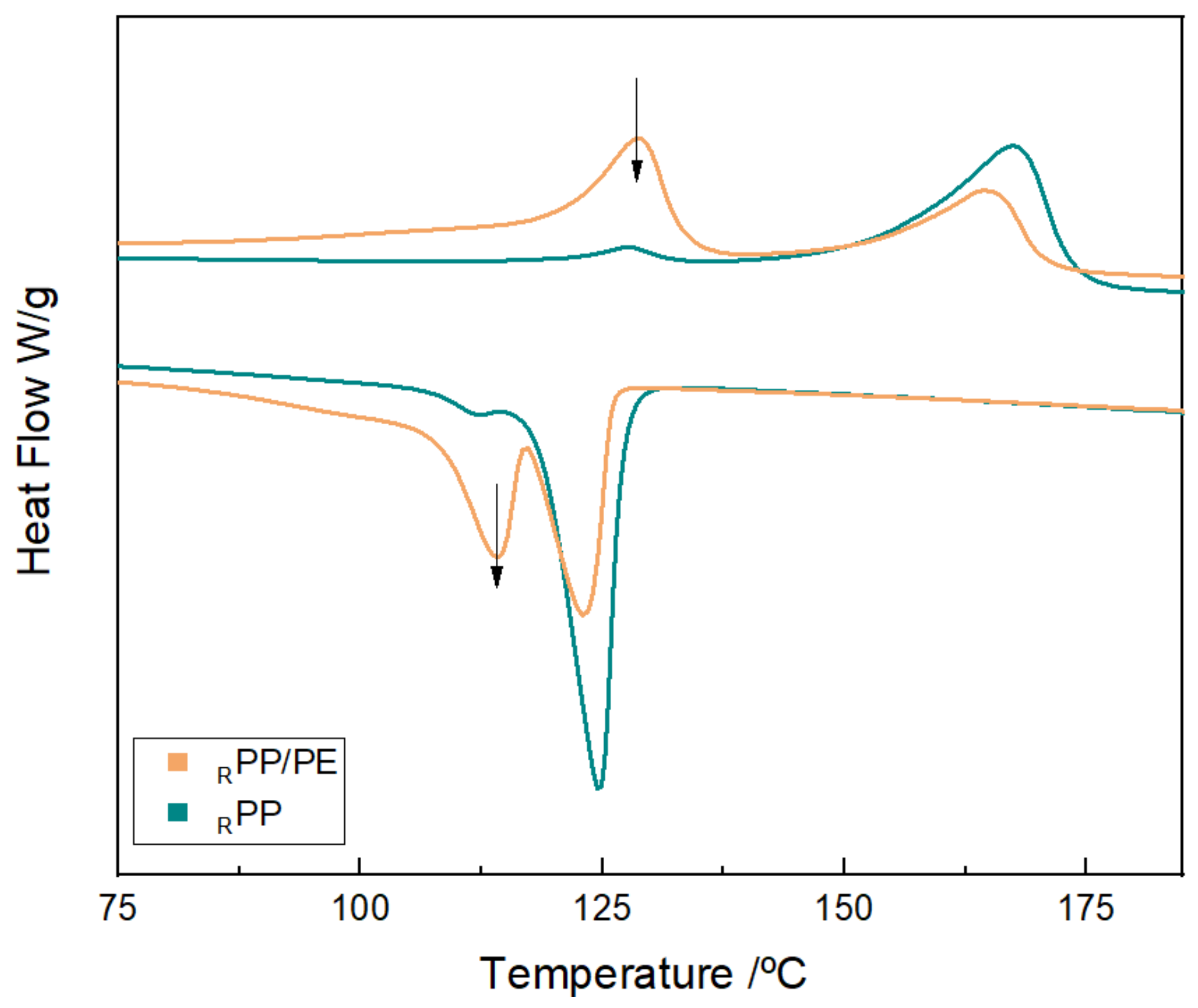
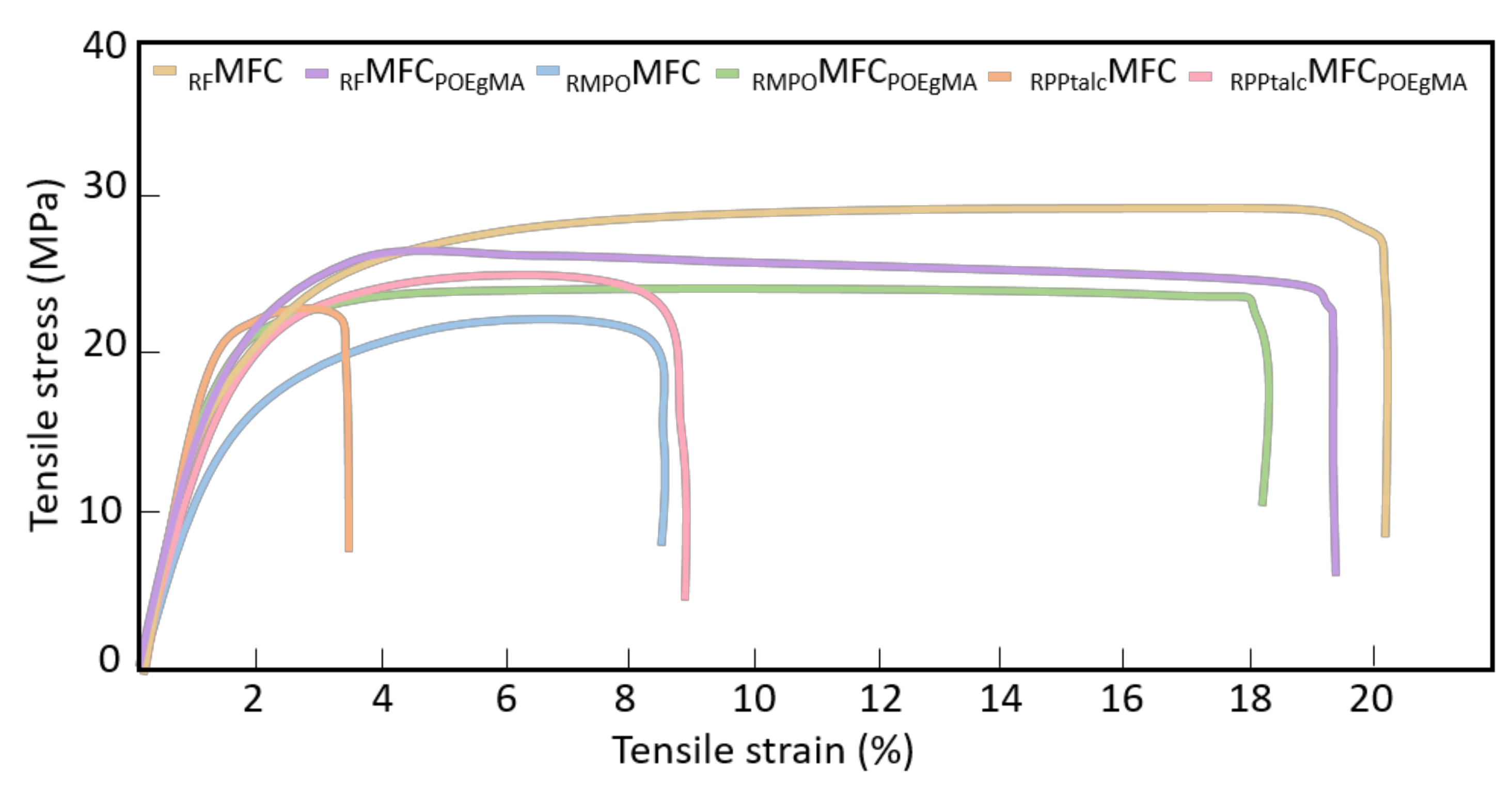
| Material | Abbreviation |
|---|---|
| Recycled film | RF |
| Recycled mixed polyolefins | RMPO |
| Recycled polypropylene filled with talc | RPPtalc |
| Abbreviations | Samples | Matrix Type wt% | PET wt% | POEgMA wt% | |
|---|---|---|---|---|---|
| RFIMB | IMB RFPP/PET | PP | 80.0 | 20.0 | - |
| RFMFC | MFC RFPP/PET | PP | 80.0 | 20.0 | - |
| RFMFCPOEgMA | MFC RFPP/PET/POEgMA | PP | 75.2 | 18.8 | 6 |
| RMPO | IMB RMPO (80PP/20PE) | MPO | 100 | - | - |
| RMPOIMB | IMB RMPO/PET | MPO | 80.0 | 20.0 | - |
| RMPOMFC | MFC RMPO/PET | MPO | 80.0 | 20.0 | - |
| RMPOMFCPOEgMA | MFC RMPO/PET/POEgMA | MPO | 75.2 | 18.8 | 6 |
| RPPtalc | IMB RPPtalc | PPtalc | 100 | - | - |
| RPPtalcIMB | IMB RPPtalc/PET | PPtalc | 80.0 | 20.0 | - |
| RPPtalcMFC | MFC RPPtalc/PET | PPtalc | 80.0 | 20.0 | - |
| RPPtalcMFCPOEgMA | MFC RPPtalc/PET/POEgMA | PPtalc | 75.2 | 18.8 | 6 |
| Sample | MFR g/10 min |
|---|---|
| Virgin PP | 8.88 ± 0.24 |
| Virgin PET | 24.8 ± 1.08 |
| RFPP/PET blend | 43.2 ± 1.68 |
| Sample | Particle Size µm ± stdev | Fibre Diameter µm ± stdev |
|---|---|---|
| RFIMB | 8.4 ± 2.9 | - |
| RFMFC | - | 3.0 ± 0.1 |
| RFMFCPOEgMA | - | 0.9 ± 0.2 |
| RMPOIMB | 1.8 ± 0.5 | - |
| RMPOMFC | - | 0.8 ± 0.1 |
| RMPOMFCPOEgMA | - | 0.8 ± 0.1 |
| RPPtalcIMB | 1.9 ± 0.9 | - |
| RPPtalcMFC | - | 0.7 ± 0.1 |
| RPPtalcMFCPOEgMA | - | 1.0 ± 0.2 |
| Sample | χcPP % | TmPP °C | TcPP °C |
|---|---|---|---|
| RFIMB | 32.3 ± 0.3 | 166.0 ± 0.5 | 116.0 ± 1.3 |
| RFMFC | 43.8 ± 3.2 | 167.0 ± 0.4 | 121.2 ± 0.8 |
| RFMFCPOEgMA | 48.6 ± 2.8 | 166.9 ± 0.5 | 115.4 ± 1.5 |
| Sample | χcPP % | ΔHmPE J/g | TmPP °C | TcPP °C |
|---|---|---|---|---|
| RMPO | 38.8 ± 0.4 | 22.9 ± 2.2 | 162.0 ± 0.1 | 124.5 ± 0.1 |
| RMPOIMB | 37.9 ± 0.8 | 18.5 ± 0.7 | 165.8 ± 0.2 | 122.6 ± 0.2 |
| RMPOMFC | 37.6 ± 1.1 | 19.3 ± 1.7 | 164.9 ± 0.7 | 122.4 ± 0.8 |
| RMPOMFCPOEgMA | 38.2 ± 0.7 | 17.3 ± 0.3 | 165.8 ± 0.9 | 122.7 ± 0.4 |
| Sample | χcPP % | χcPE % | TmPP °C | TcPP °C |
|---|---|---|---|---|
| RPPtalc | 45.8 ± 1.1 | 13.4 ± 0.2 | 165.6 ± 1.8 | 125.8 ± 0.1 |
| RPPtalcIMB | 47.9 ± 0.3 | 15.0 ± 2.6 | 167.1 ± 0.3 | 122.9 ± 0.5 |
| RPPtalcMFC | 46.1 ± 0.7 | 13.3 ± 0.4 | 166.0 ± 0.3 | 123.7 ± 2.7 |
| RPPtalcMFCPOEgMA | 46.6 ± 0.5 | 10.7 ± 2.5 | 167.1 ± 0.4 | 122.2 ± 0.1 |
| Sample | Impact Strength kJ/m2 | Tensile Modulus GPa | Yield Strength MPa | Strain at Yield % | Strain at Break % |
|---|---|---|---|---|---|
| RFIMB | 4.1 ± 0.1 | 1.57 ± 0.06 | 22.5 ± 0.8 | 7.80 ± 0.2 | 38.3 ± 7.8 |
| RFMFC | 4.6 ± 0.4 | 1.60 ± 0.11 | 28.2 ± 1.3 | 11.8 ± 3.1 | 20.3 ± 1.6 |
| RFMFCPOEgMA | 4.7 ± 0.4 | 1.21 ± 0.08 | 26.9 ± 0.5 | 9.90 ± 0.4 | 19.2 ± 4.1 |
| Sample | Impact Strength kJ/m2 | Tensile Modulus GPa | Yield Strength MPa | Strain at Yield % | Strain at Break % |
|---|---|---|---|---|---|
| RMPO | 6.5 ± 0.4 | 1.03 ± 0.11 | 23.2 ± 0.4 | 12.2 ± 0.3 | 25.6 ± 6.0 |
| RMPOIMB | 4.4 ± 0.2 | 1.25 ± 0.08 | 22.1 ± 0.5 | 7.21 ± 0.5 | 11.9 ± 1.9 |
| RMPOMFC | 4.6 ± 0.5 | 1.30 ± 0.11 | 20.9 ± 1.3 | 6.18 ± 0.7 | 8.27 ± 2.1 |
| RMPOMFCPOEgMA | 7.2 ± 0.4 | 1.13 ± 0.08 | 23.0 ± 0.5 | 12.2 ± 0.1 | 18.2 ± 3.2 |
| Sample | Impact Strength kJ/m2 | Tensile Modulus GPa | Yield Strength MPa | Strain at Yield % | Strain at Break % |
|---|---|---|---|---|---|
| RPPtalc | 4.2 ± 0.2 | 2.1 ± 0.09 | 23.9 ± 0.7 | 4.6 ± 0.1 | 11.3 ± 0.2 |
| RPPtalcIMB | 2.7 ± 0.1 | 2.2 ± 0.12 | 22.9 ± 0.4 | 2.8 ± 0.1 | 3.47 ± 0.3 |
| RPPtalcMFC | 2.8 ± 0.1 | 2.2 ± 0.08 | 22.4 ± 0.6 | 2.7 ± 0.1 | 3.33 ± 0.3 |
| RPPtalcMFCPOEgMA | 5.2 ± 0.2 | 1.7 ± 0.15 | 23.8 ± 1.3 | 5.9 ± 0.6 | 8.67 ± 1.0 |
Publisher’s Note: MDPI stays neutral with regard to jurisdictional claims in published maps and institutional affiliations. |
© 2021 by the authors. Licensee MDPI, Basel, Switzerland. This article is an open access article distributed under the terms and conditions of the Creative Commons Attribution (CC BY) license (http://creativecommons.org/licenses/by/4.0/).
Share and Cite
Kuzmanović, M.; Delva, L.; Cardon, L.; Ragaert, K. The Feasibility of Using the MFC Concept to Upcycle Mixed Recycled Plastics. Sustainability 2021, 13, 689. https://doi.org/10.3390/su13020689
Kuzmanović M, Delva L, Cardon L, Ragaert K. The Feasibility of Using the MFC Concept to Upcycle Mixed Recycled Plastics. Sustainability. 2021; 13(2):689. https://doi.org/10.3390/su13020689
Chicago/Turabian StyleKuzmanović, Maja, Laurens Delva, Ludwig Cardon, and Kim Ragaert. 2021. "The Feasibility of Using the MFC Concept to Upcycle Mixed Recycled Plastics" Sustainability 13, no. 2: 689. https://doi.org/10.3390/su13020689
APA StyleKuzmanović, M., Delva, L., Cardon, L., & Ragaert, K. (2021). The Feasibility of Using the MFC Concept to Upcycle Mixed Recycled Plastics. Sustainability, 13(2), 689. https://doi.org/10.3390/su13020689






